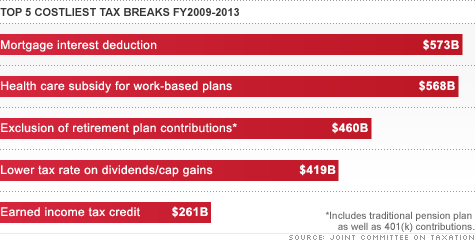
NEW YORK (CNNMoney.com) -- The government does without roughly a trillion dollars a year because of a slew of tax breaks -- everything from the mortgage-interest deduction, to education and child credits, to low rates on investments.
The irony is that all those breaks can translate into higher tax rates and a federal budget that is much bigger than advertised, according to tax experts Len Burman, a professor at Syracuse University, and Edward Kleinbard, a professor at University of Southern California.
Anyway you slice it, a cool trill is not chump change. In fact, it's equal to nearly a third of the federal budget.
But you won't actually see that highlighted in the federal budget process every year. That's because lawmakers focus on the money the government will spend and how much it will raise in taxes. But "total revenue passed up" doesn't really come up.
Burman and Kleinbard think tax breaks should be treated as a form of spending.
"Like direct spending programs, tax expenditures crowd out other spending and require higher tax rates than otherwise needed," Burman wrote in a paper co-authored with Eric Toder and Christopher Geissler.
Even though tax breaks lower the tax bite for eligible individuals and corporations, they end up raising taxes on others.
"Targeted tax relief is just another name for government spending, in which taxes extracted from those of us who are not targeted fund hidden spending on those who are," said Kleinbard, who used to run the Joint Committee on Taxation, in a speech last fall.
If lawmakers did treat tax breaks as spending, the size of the federal budget -- defined by how much the government will spend in a year -- would be more like $4.6 trillion, not $3.6 trillion.
The number of tax breaks has quadrupled since 1972. No one advocates that all tax breaks be abolished. But Burman has suggested lawmakers cap how much they spend on them.
Done right, such breaks can advance government-favored activities such as giving to charities, boosting retirement savings or purchasing health insurance.
But even when the mission is clear, lawmakers' aim isn't always dead-on. For example, a tax break might encourage behavior that would have happened without a government subsidy.
Done wrong, tax breaks can squander resources that could be put to better use.
"These revenues could be used to lower marginal tax rates, fund more social programs, improve infrastructure, eliminate budget deficits, or promote various other purposes," Burman and his colleagues wrote.
The problem, Kleinbard and Burman say, is that most tax breaks don't get much scrutiny once they become law. By contrast, Congress each year must review discretionary spending, such as that on defense, education and infrastructure.
Some tax breaks, of course, have expiration dates. But even then they're often lumped together with other expiring tax breaks and renewed en masse.
"If we can force tax expenditures into the sunlight, by subjecting them to the full rigor of the budget process, we can make better choices," Kleinbard said.
In view of the country's looming fiscal shortfalls, the discussion about tax breaks isn't just academic.
Tax experts have been saying for years that streamlining tax breaks and simplifying their rules is key to reforming the tax code. And let's face it, you'd have to pay someone an obscene amount of money to say without laughing that the code, with its mind-bending complexity, is just fine.
As it is, tax breaks can increase the sense that the tax code is unfair and make people feel better about cheating. It's always the other guy it seems who's getting more breaks and the wealthiest corporations getting the sweetest deals.
Among the benefits of rethinking tax breaks: it could lead to a broader base of people paying into the federal income tax system.
Today, because of the multitude of tax breaks, nearly half of all tax filers will end up owing no federal income tax, according to Roberton Williams, a senior fellow at the Tax Policy Center.
With fewer tax breaks, more people will end up with some federal income tax liability. But with more people paying in, that could also mean tax rates wouldn't need to be as high as they otherwise might be. ![]()






| Index | Last | Change | % Change |
|---|---|---|---|
| Dow | 32,627.97 | -234.33 | -0.71% |
| Nasdaq | 13,215.24 | 99.07 | 0.76% |
| S&P 500 | 3,913.10 | -2.36 | -0.06% |
| Treasuries | 1.73 | 0.00 | 0.12% |
| Company | Price | Change | % Change |
|---|---|---|---|
| Ford Motor Co | 8.29 | 0.05 | 0.61% |
| Advanced Micro Devic... | 54.59 | 0.70 | 1.30% |
| Cisco Systems Inc | 47.49 | -2.44 | -4.89% |
| General Electric Co | 13.00 | -0.16 | -1.22% |
| Kraft Heinz Co | 27.84 | -2.20 | -7.32% |
|
Bankrupt toy retailer tells bankruptcy court it is looking at possibly reviving the Toys 'R' Us and Babies 'R' Us brands. More |
Land O'Lakes CEO Beth Ford charts her career path, from her first job to becoming the first openly gay CEO at a Fortune 500 company in an interview with CNN's Boss Files. More |
Honda and General Motors are creating a new generation of fully autonomous vehicles. More |
In 1998, Ntsiki Biyela won a scholarship to study wine making. Now she's about to launch her own brand. More |
Whether you hedge inflation or look for a return that outpaces inflation, here's how to prepare. More |